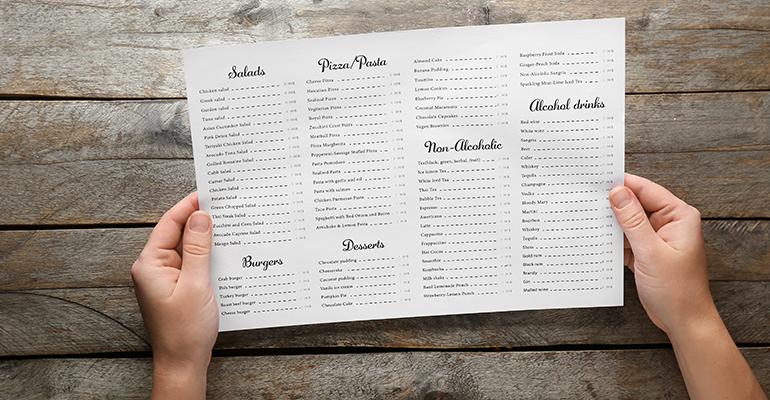Senior food and beverage editor Bret Thorn and food trend expert Nancy Kruse discuss the latest cultural trends in this column.
Nancy Kruse begins:
It appears, Bret, that this protracted pandemic has induced consumers to clean up and clean out in epic proportions. Media outlets in markets as far flung as Boston and Birmingham, Miami and Missoula have featured stories on a decluttering boom that has come to resemble spring cleaning on steroids. Primary beneficiaries have been charities like Salvation Army and Goodwill; the latter, in fact, is reported to be busily renting warehouses to contain tsunamis of stuff and hiring new employees to help sort and store the unexpected deluge of donations.
Food and restaurant companies have felt the urge to purge, too. During an earnings call at the end of July, executives of packaged-goods firm Mondelez, maker of brands like Oreo and Cadbury, announced their plan to cut their SKUs by 25% in order to simplify their supply chain, reduce costs and enhance profits.
Similar initiatives have been launched by restaurant company execs. Beset by a devastating double whammy of store shutdowns and staff layoffs, lots of operators have taken the scalpel to their menus.
Judicious pruning by McDonald’s increased drive-thru speeds by 15 seconds while increasing customer satisfaction scores. This led CEO Chris Kempczinski to vow that any item reinstated must “earn its way back onto the menu.”
 Competitor Taco Bell recently announced another round of menu cuts to occur in November; this comes on top of 12 items jettisoned this summer and nine that were chopped last year. The stated purpose of all this culinary cropping is to eliminate so-so performers, make more room for plant-based items, and, yes, to enhance speed of service at the drive-thru.
Competitor Taco Bell recently announced another round of menu cuts to occur in November; this comes on top of 12 items jettisoned this summer and nine that were chopped last year. The stated purpose of all this culinary cropping is to eliminate so-so performers, make more room for plant-based items, and, yes, to enhance speed of service at the drive-thru.
It’s not just quick serves who are dramatically downsizing their bills of fare. Full-service operators are doing the same, and some of the reductions seem positively draconian. Cheesecake Factory got rid of a whopping 40 items as it closed its dining rooms and downsized its kitchen staffs this spring. Dine Brands, parent of IHOP and Applebee’s, chopped the number of items at both chains by about one third, and management says there are no plans to bring them back once things return to normal.
And so it goes. Cracker Barrel’s new dinner menu debuted with 10 fewer items, Bloomin’ Brands streamlined menus at both Outback Steakhouse and Carrabba’s Italian Grill, and Denny’s 86ed a range of items including selected skillets, pancakes, burgers and pot roast. Meanwhile, Panera Bread took action on two fronts, removing some sandwiches on the one hand, while introducing others at a lower price point to appeal to cash-strapped customers on the other.
Although it took COVID to force the issue, some of us think chain menus should have been put on a diet a long time ago. Bloated Menu Syndrome, BMS, has been a creeping, insidious phenomenon that has caused many operators to stray far off brand in an attempt to remain competitive and relevant. Relatively few have been immune to BMS, as competitive conditions and economic imperatives have driven many to relentlessly chase the latest bright, shiny menu item.
I’m wondering, Bret, if you think these newly slimmed-down menus will stick around once we return to business as usual? Despite recent chain unit closures, I suspect that we will remain in a state of oversupply in many markets as we move into and through next year. And of course, we’ll be confronting additional layers of COVID-driven competition: Ghost kitchens and virtual brands are on the ascendant, and grocers are giddy with surging sales that they’ll fight hard to retain.
So will all this menu rationalization, this feverish rightsizing to find the menu mix that delivers the goods to both patrons and the bottom line, be a long-term trend, or do you believe, as I do, that over time, it will slowly but surely fall victim once again to Bloated Menu Syndrome?
 Bret Thorn responds:
Bret Thorn responds:
Nancy, I think trimming down menus is, in some ways, similar to trimming down waistlines. It takes discipline to do it, and continued discipline to keep the fat off, but if you can manage it, you’ll probably be better off.
Dine Brands CEO Steve Joyce told me that Applebee’s and IHOP had been trying to get rid of menu items for years, but franchisees would balk. If one IHOP operator had a loyal guest who liked the chain’s tilapia, then there’d be pushback about removing it.
But cratering sales and customer traffic, supply chain SNAFUs, reduced labor, the challenges of menu development while socially distancing, emotional anguish and whatever other problems operators have been saddled with over the past six months have forced them to streamline operations.
Meanwhile, customers have been more forgiving and Tilapia-Ordering Guy has learned to settle for the chicken.
As with previous recessions, operators have taken the time to take stock of what they’re doing, becoming leaner and smarter and realizing that maybe they don’t need to offer 42 different burger toppings when most people get cheese, lettuce, tomato and ketchup.
This should be wonderful. It should mean that the food will be better prepared, the staff better trained, order mistakes fewer, food brought out more quickly, customers more satisfied and restaurants more profitable.
The decision to get rid of menu items can be tough, but the results can be excellent.
Mooyah Burgers, Fries and Shakes got rid of their chicken sandwiches in 2018 because, as vice president of operations Mike Sebazco told me, the chain’s burgers were unique, but the chicken really wasn’t, and people who ordered the sandwiches wouldn’t see Mooyah at its finest.
Franchisees were not crazy about the idea, until they found out that, by not selling chicken, food and labor costs came down, and faster service times resulted in a 6% increase in traffic.
Chains that stick to what they do best tend to perform well.
Raising Cane’s Chicken Fingers, which sells chicken fingers, Texas toast, fries, coleslaw, soft drinks and one sauce, consistently ranks among the fastest-growing chains in terms of sales in Nation’s Restaurant News’ annual Top 200 census.
So does Chick-fil-A, which mostly focuses on its single protein and assorted accoutrements.
Happy people understand that they can’t be all things to all people, and restaurants should realize that, too.
But will there be a return to BMS? Nancy, you know the answer to that: Of course there will be.
Even as many restaurants trim their menus, my weekly Menu Tracker column once again is full of new items.
Innovation didn’t even stop during the early weeks of the pandemic, although it changed. Restaurants adapted, sometimes literally in days, to the situation and started selling groceries, bundled family meals and kits for their guests to cook and assemble at home.
And now some of the innovation is low on labor and high on impact. For example, Panera Bread has combined its extremely popular broccoli and cheddar soup with mac & cheese to introduce broccoli cheddar mac & cheese. That should require no new SKUs and, I would think, minimal training.
Buffalo Wild Wings has rolled out new sauces, which is about as operationally simple as you can get — and also “cauliflower wings,” one of those plant-based options you mentioned.
Others are probably more labor intensive but are in touch with the times, like Domino’s Pizza, which rolled out a cheeseburger pizza and a chicken taco pizza, reasoning that burgers and tacos don’t travel as well as pizza.
That’s kind of gimmicky, but not as gimmicky as what Carl’s Jr. and Taco Bell Canada are doing by teaming up with wineries to pair drinks with new menu items.
Carl’s Jr. worked with Nocking Point Wines to select three bottles that customers could order from the winery to pair with the chain’s new Steakhouse Angus Thickburger. The $68 Steakhouse Burger Box also comes with a gift card to buy the burger.
Taco Bell Canada worked with Queenston Mile Vineyard in Ontario to develop a wine, Jalapeño Noir, meant to pair with the new Toasted Cheesy Chalupa, that guests could order from Taco Bell.
They could only do that at two restaurants in the whole country, and only via Uber Eats, highlighting the gimmicky nature of the effort, but it also was done to promote the new Chalupa, which is slated to be introduced in the United States in November.
And already chains are jumping on trends. Doughnuts have become a favorite during the pandemic, so much so that Japanese beef bowl concept Yoshinoya sells them now. I’ve lost count of how many chains have rolled out fried chicken sandwiches, riding on the coattails of Popeyes’ breakout success.
El Pollo Loco has introduced what it claims to be the first keto burrito — keto’s not a particularly new trend, but it’s a trend.
Meanwhile, Einstein Bros. Bagels has teamed up with sous-vide experts Cuisine Solutions to come up with Eggels, which are sandwich fixin’s mixed with eggs, formed into the shape of bagels and cooked sous-vide to form what look sort of like bagel-shaped frittatas. Are they good? I haven’t tried them, but they are gluten-free.
Smart chains will add new items judiciously while removing others, rotating limited-time-offers as appropriate and keeping in mind operational challenges that come with each new SKU.
But I’d be surprised if, by 2023, we aren’t having a conversation like this all over again.
Nancy Kruse, president of the Kruse Company, is a menu trends analyst based in Atlanta and a regular contributor to Nation’s Restaurant News.
Contact her at [email protected]
Contact Bret Thorn at [email protected]
Follow him on Twitter: @foodwriterdiary





